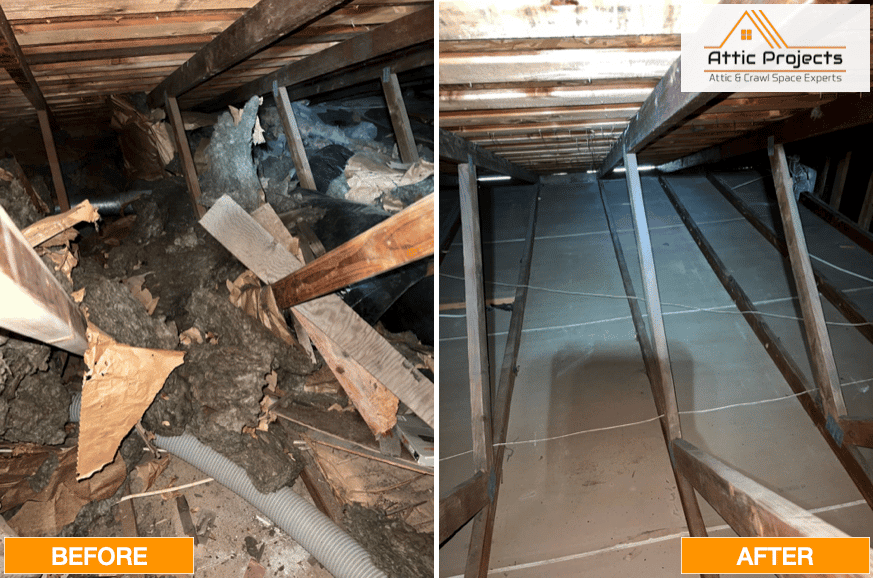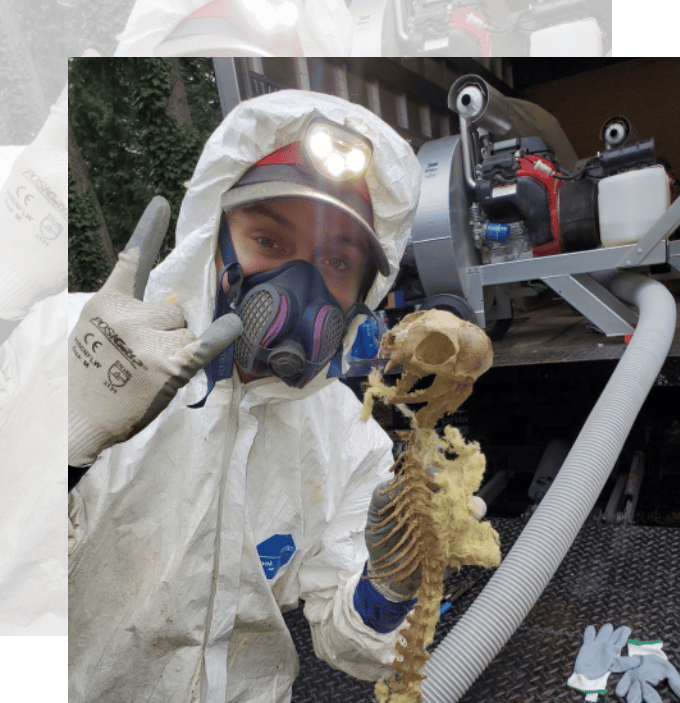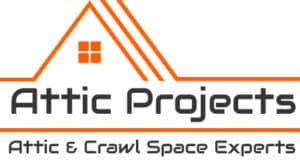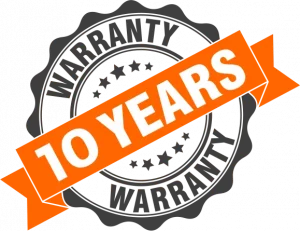
Should Wet Insulation Be Replaced?
Insulation is key in keeping your home comfortable and reducing energy usage. But it also faces various threats, with moisture being chief among them. Wet
Fill out the form or call at
Attics are considerably great hiding places for rodents that can have adverse impacts on human health. Particularly, troublesome pests such as mice, rats, possums, and raccoons usually thrive in the highly populated area, where you unknowingly offer them shelter and food. Such pests will live comfortably in your attic.
At Attic Projects, we have a wide range of experience offering successful attic clean-up services. We have a team of well-trained staff, who have seen all there is in attic cleaning services. Regardless of the attic cleanup situation that you have, we will do our best to leave your attic all cleaned up.

Perhaps you have experienced a very foul smell coming from your attic, or you constantly hear scurrying noises, or you have even seen a few rodent droppings? These are signs that your attic is full of pests. If you wait any longer, the problem will worsen. In our attic cleaning services, we have come across homesteads with heavy contaminations of droppings all over the attic and the insulations. Our goal is to remove all these contaminants including foul odors, and droppings, to make your home feel new again.
The presence of droppings around your home and specifically in the attic is an indication that your home is infested with harmful pests.
For instance, rodents stay in the walls where they not only pollute insulation but also gnaw at them. They are also responsible for the growth of molds, bacteria, and fungus. We come in to help restore order in your living space.
We understand how these pests grow and we encourage that you deal with them immediately if you see any tell-tale signs such as droppings or hear scurrying noises in the attic. Ignoring these vermin will lead to their increase and with them a greater prevalence of disease and damage to property. Additionally, the large ecosystem can be costly to deal with as it implies more droppings to deal with, and more paths to seal. However, you have nothing to worry about. Technicians and staff at Attic Projects have the skills, experience, and the appropriate equipment to deal with any size of pests’ ecosystem that may be inhabiting your home.

Most people would consider doing the cleanup of their attic by themselves. While this may appear a great decision and a saving point, what you do not know is that effective attic cleaning services are a complex affair that requires the combination of skills and the right equipment.
For instance, at Attic Projects, we not only clean your attic but also ensure that all your electrical, insulation, plumbing, or HVAC systems are operational. Doing the clean-up yourself means you engage different contractors to attend to your damaged property. For example, you will need to hire a plumber for your damaged pipes, and an electrician for your electrical equipment. We take this entire burden off you and do everything ourselves. Our cleanup exercise is comprehensive as our aim is to ensure that all our customers are satisfied.
Attic Cleaning | Attic Sanitation | Mold Remediation | Attic Insulation Installation | Attic Insulation Removal | Radiant Barrier Insulation | Air Duct Sealant & Repair | Rodent Proofing & Removal | Attic Remodeling & Storage | Attic Stairs & Doors | Asbestos Removal | Water Damage Restoration | Fire Damage Restoration
Santa Ana | Orange County | Seattle | Everett | San Diego

At Attic Projects, we offer comprehensive attic cleaning services designed to increase energy efficiency, improve air quality, and reduce health risks. As part of this process, debris, dust, and contaminants are removed, followed by thorough vacuuming and sanitization, and insulation, air leaks, and rodent entryways are inspected and addressed.
Maintaining a clean attic is crucial for many reasons. Professional cleaning can help ward off mold, keep pests at bay, and ensure everything runs efficiently. If you’re worried about your energy bills, the air you breathe, or potential issues in your attic, our professional cleaning services at Attic Projects are tailored to your needs and can benefit you in more ways than one!
How long attic cleaning takes can vary depending on the attic’s condition and what needs to be done. For a basic attic cleanup where we tidy up, sweep, and remove any clutter or debris, it typically takes 4-8 hours. However, a major rodent infestation or a lot of droppings and nesting material must be cleared out and disinfected. In that case, attic cleaning can take 8+ hours or sometimes longer over multiple visits. The extent of the feces, urine, nests, and carcasses that need to be removed and the attic properly sanitized plays a big role. We’ve seen some attics so overrun with mice or rats that the cleanup process takes over a week.
Attic cleaning also addresses odors by eliminating sources of contamination and using effective sanitizing agents. Our process enhances cleanliness and creates a fresher, more pleasant living environment by tackling and eliminating unpleasant odors.
Attic Projects has locations thought-out southern California and Washington State. We provide attic cleaning from our home offices in Seattle, WA, Everett, WA Orange, CA and San Diego.
We doubt that you’ll need us again, but if you do — we got you covered.

*Insulation materials qualify for our 20 Year Warranty

We doubt that you’ll need us again, but if you do — we got you covered.
*Insulation materials qualify for our 20 Year Warranty
Rodents are a nightmare for any homeowner. They can lower the value of your home by causing serious damage, foul odors, and extensively unsanitary conditions. They also pose a significant health risk to you and your family by spreading disease and causing illness. The last thing you want is to waste your time removing rodents, only to have them move right back in. At Attic Projects, we not only humanely remove the rodents and pests from your home, but we also rodent-proof your home so they can’t come back. In order to keep the pests and rodents out permanently, you have to close up every entry point that they may squeeze into. Call Attic Projects today to get your free estimate.
Fill out the form or call us at

Insulation is key in keeping your home comfortable and reducing energy usage. But it also faces various threats, with moisture being chief among them. Wet

Summer may be a time of refreshing swims and exciting road trips, but the season also brings many challenges for homeowners. In particularly humid climates,

HISTORY OF FIBERGLASS INSULATION Fiberglass insulation, a material widely used in modern construction, has a history that dates back to the 1930s. The Owens Corning
